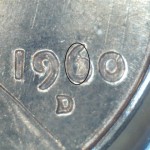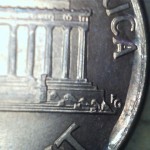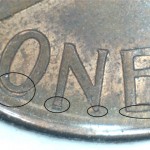A • B • C • D • E • F • G • H • I • J • K • L
M • N • O • P • Q-R • S • T • U • V • W • X-Z
Welcome to the Lincoln Cent Forum Glossary.
Use the alphabetical links above to navigate to the desired term.
This glossary of terms was written and compiled by Will Brooks with the help of our forum members. A huge thanks to everyone who contributed knowledge, ideas, words, and photos to make this growing educational resource possible. Special thanks to Richard Cooper, aka “Coop” who donated many of the photos.
D Mint Mark : A cent struck at the Denver mint will bear a letter D on the obverse below the date. (Note: The D mint mark was also used on gold coins from 1838-1861 that were struck at the Dahlonega Mint.) You can see changes in the D mint mark styles here at varietyvista.com.
Dansco: A company that sells coin albums and other coin supplies.
DE: See Initials.
Deep Cameo: See Cameo.
De-plated: See Stripped Plating.
Design Extension Anomaly: An unintentional protraction of design elements, such as trails, dimples, and wavy steps. These are believed to happen to the working die during the hubbing process, and have an unknown cause.
Design Hub Doubling: Also called a class 3 doubled die, Design Hub Doubling occurs when a die is made with 2 different hubs having different designs on them. There are some occurrences in the Lincoln series during years with both a “large date” and “small date,” where some dies were hubbed by a both a small date hub and a large date hub, thereby creating a class 3 doubled die. Below is a 1960D “small date over large date.” Also please see Jason Cuvelier’s excellent tutorial on the subject Here.

Details (grade): When a coin has surface issues that preclude a third party grading service from assigning it a full numerical grade, it is sometimes assigned a “details” grade. The details grade will be determined by the amount of wear on the coin without regard to the surface problems.
Devices: Any of the raised or incuse design elements on a coin.
Die: See Working Die or Master Die.
Die Attrition: An error to the periphery of a coin caused by damage to the hammer die created when a misalignment of the die results in it striking the edge of the collar. After repeated hits on the collar, a portion of the edge of the die is worn away, and then when the die is later properly aligned, that damaged part of the die is no longer able to strike and create the intended design on the planchet. In the case of Lincoln cents, this type of error is most often found on 1983 cents.

Die Break: When a piece of the die breaks and falls out. This term encompasses cuds (connected to the rim), die chips (small and not connected to the rim), and interior die breaks (large and not connected to the rim).
Die Cap: When a just-struck coin fails to eject the striking chamber and becomes stuck to one of the dies. If it stays stuck, it can subsequently strike other planchets fed into the striking chamber, creating a mirror-image in opposite relief of the opposing die’s design on the new planchet. (See Brockage) A die cap will continue to expand as it strikes other planchets resulting in either extreme diametric expansion (stuck to anvil die) or a “thimble-like” expansion (stuck to hammer die). The other coins struck by the die cap are called “Struck through die cap.” After a die cap has struck many other planchets, it is called a late-stage die cap. A late stage die cap will be thin enough to allow parts of the normal die design to appear on the struck planchets. (See Struck Through Late Stage Die Cap.)

Die Chip: When a piece of the die breaks and falls off, the subsequent coins struck by that die will show a raised unstruck portion that usually looks like a “blob” of extra metal on the coin. This is simply from the metal flowing into the opening in the die during the strike.

Die Clash: An error that occurs when the dies come together without a planchet between them and they strike against each other, transferring a portion of their designs onto each other. Each subsequent coin struck by these dies will show portions of the designs on the opposite sides of the coin and in opposite relief. The first picture shows clash marks of the memorial columns on the obverse, the 2nd picture shows the back of Lincoln’s neck in bay 3, and the 3rd photo shows the upside-down Y of LIBERTY in bay 2 as well as clash remnants in bays 3 and 4.



Die Crack: A fissure in the die which will result in a raised line on a coin that is struck by that die.



Die Damage: Any unintentionally displaced metal on a die including any die break, such as die chips and die cracks, as well as any die dents, die gouges, or die abrasion.
Die Dent: Any unintentional impression into the die face. The portion of the coin struck by the die dent will show as raised metal.



Die Deterioration: Wear to the die from the process of striking coins. The amount of deterioration to the die at the time a coin was struck (see Die State) can be determined by various attributes seen on the coin itself. Wear to the die can manifest itself in the form of flow lines, ridge rings, die deterioration doubling, “mushy” devices, and progressive indirect design transfer.
Die Deterioration Doubling: A circumstance that occurs from die deterioration whereby the devices show a duplicate image on a coin. As metal must flow into the recessed areas of the die during the strike to form the devices on a coin, the edges and corners of the design elements on the die begin to wear. Eventually, this wear shows as a doubled image on the coins they strike. On Lincoln cents, the date and mint mark are often the first to show this doubling, since these devices are in the middle of a field with no other counter-relief to aid metal flow. Die deterioration doubling usually exhibits on the rim side of the devices, as in the example below. The 1955 “Poor Man’s Doubled Die” is NOT a doubled die at all, rather it is an example of die deterioration doubling. Dies in this time period were grossly “overused” resulting in many coins showing this common form of doubling. Die deterioration doubling is not generally considered collectible. Photo of the 1955 “poor man’s doubled die” is courtesy of forum member dinkyblue. Please also see Jason Cuvelier’s excellent tutorial on the subject Here.



Die Dot: A tiny die chip that looks like a dot.
Die Gouge: A furrow of metal scraped out of a die. Like other recessed die damage, the result will be a raised section of metal on the coins the die strikes.

Die Scratch: Small scratches in the die can occur by either accidental means, or by purposeful abrasion of the die by the mint. They might do this intentionally to try to remove die clash marks or other die damage. These die scratches are unique to each die and are therefore useful as markers for identifying a particular die. Since scratches are incuse on the die, they appear as thin raised lines on the coins.

Die State (stage): The dies that strike coins deteriorate over their life-spans. (See Die Deterioration) Coins are differentiated by how early or late in a die’s life they are struck. This can be determined by attributes (or the lack thereof) seen on the coin such as flow lines, ridge rings, “mushiness” of the devices, die deterioration doubling, and the progression of various die breaks. There are three main Die States: EDS (Early Die State), MDS ( Mid Die State), and LDS (Late Die State). On occasion, the need to further differentiate these states occurs and hence you may also see VEDS (Very Early Die State), EMDS (Early-Mid Die State), MLDS (Mid-Late Die State), and VLDS (Very Late Die State). Furthermore, each of these states can be further broken down into “stages.”
Visit this thread for more valuable information: http://lincolncentresource.net/forums/showthread.php?t=30508
Die Subsidence (sunken die): An error where a portion of the die face sinks into the die resulting in a raised portion on one face of the coins it strikes, and often exhibits weakness of strike of the opposite side. The most well-known instance in the Lincoln series is on a 1924S, commonly known as the “goiter” cent.


Die Variety: An abnormal coin struck from a die that had a mistake made during the transfer of its design onto the die. Die varieties include doubled dies, re-punched and misplaced mint marks, over mint marks, dual mint marks, and re-punched and misplaced dates. (The practice of punching the date into the die stopped before the Lincoln Cent series began, so there are no re-punched or misplaced dates on Lincoln cents) These are NOT considered “errors.”
Distended Hub Doubling: Also called a Class 6 Doubled Die, distended hub doubling occurs when the design elements on a working hub are flattened out during the hubbing of a die, most likely because the die it is making was not properly annealed. The die now will also exhibit these stretched out design elements, as will all of the coins struck by that die. Distended Hub Doubling usually manifests itself on the devices nearer the rim.

Distorted Hub Doubling: Also called a Class 2 Doubled Die, distorted hub doubling occurs when a die is hubbed with 2 different hubs, one of which had distended design elements from either hubbing many other dies prior or because of a problem in the annealing process. If the normal hub was used before the distorted hub, the doubling will show on the rim side of the devices. If the distorted hub was used before the normal hub, then the doubling will show toward the center of the coin. Please see Jason Cuvelier’s excellent tutorial on the subject Here.

Division Lines (Separation Lines): The lines that show the separation between the doubled devices on a doubled die. These lines are often accompanied by “notching” at the ends or serifs of the doubled devices.

Double Die: An incorrect term often misused in place of the intended terms “doubled die,” or “Hub Doubling.”
Doubled Die: A coin that has been struck by a die which experienced an unintended misalignment or design inconsistency during the hubbings used to create it, resulting in a “doubling” of the devices on the coin. Doubled Dies are classified by 9 distinct classes. Class 1 (Rotated), Class 2 (Distorted), Class 3 (Design), Class 4 (Offset), Class 5 (Pivoted), Class 6 (Distended), Class 7 (Modified), Class 8 (Tilted), and Class 9 (Shifted). Please see the individual listings of each class for definitions and examples.
Double Strike: A coin that failed to completely eject from the striking chamber and was therefore either partially or completely struck a second time. This should not be confused with Strike Doubling, which is another term for machine doubling.

Dropped Letter: This is a type of struck-through where the “gunk” that is stuck in a filled die falls out and lands on a planchet before being struck. The “gunk” that is in the shape of a letter or digit is then struck into the planchet producing an incuse extra letter or digit. It could be oriented normally or in mirror-image, depending on how the gunk landed on the planchet. The photo below shows a dropped letter B from LIBERTY.

Dryer Coin: A coin that has been extremely damaged outside of the mint by being repeatedly hit, similar to what would happen to it if it tumbled around in a dryer or similar device. In an actual dryer, the heat would soften the metal increasing the damage.

Dual Mint Mark: A coin that was struck by a die having 2 completely separate and different mint marks punched into it. Not to be confused with “over mint mark,” which is two overlapping and different mint marks, such as a “D over S” or “S over D,” dual mint marks will be completely separated form each other. In the case of Lincoln cents, there were believed to be 2 known instances of a dual mint mark. A 1956D with a possible rogue S, whose validity is disagreed upon by various experts, and a 1980D with a rogue “S” which has been debunked by all major attributors after examinations of early die-state specimens showed the anomaly to be a series of die gouges.
